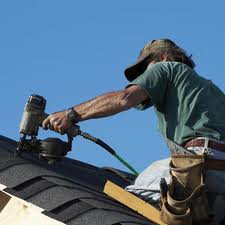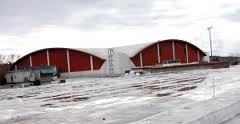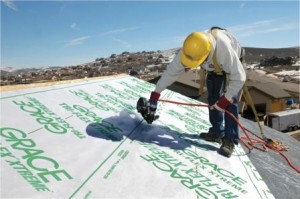Archive for February, 2012
Colorado Springs Family Gets Free Roof

When Old World Roofing was looking for a deserving family or organization to receive a new roof, Beth Wilcox wrote a touching essay about her grandmother Mary Wilcox. Mary takes care of her grown son with cerebral palsy and lives on a fixed income. The Wilcox home was in desperate need of a new roof and insulation and the Wilcox family did not have the money for the repairs.
Rolf Whitley, Old World Roofing owner, said the roof they tore off was the original and there was no insulation to keep the home warm. The project would have cost in the neighborhood of $9,800 but Old World Roofing provided both the roof and insulation for free.
More Free Roofs
70 people submitted essays for this contest. Old World Roofing will be putting on a second free roof next week at the Alano House, a facility for substance abusers.
Old World Roofing is in Colorado Springs, Denver and Pueblo Colorado. The roofing company has been serving the Front Range since 1977. Rolf Whitley hopes to be doing this again next year and give roofs to deserving people in the community.
Community Outreach Buys New Roof For ACA
 The American Civic Association building will get a new roof after several community initiatives raise money for the project. A vital part of community life and citizenship, the ACA provides important community services such as assisting immigrants with citizenship and learning English. The organization has struggled to perform services for locals under an aging building.
The American Civic Association building will get a new roof after several community initiatives raise money for the project. A vital part of community life and citizenship, the ACA provides important community services such as assisting immigrants with citizenship and learning English. The organization has struggled to perform services for locals under an aging building.
Spring Brings New Life
In just a few short weeks, roofers will break ground on improving the American Civic Association building. The improvement project comes as part of a community outreach mission to bring new life to Binghamton, NY. One year after a tragic shooting that devastated ACA employees, locals had the idea to raise money to replace the roof as a way to symbolize moving on from hard times.
The staff of the American Civic Association pooled their money for an initial donation of $1,000, which was topped by a $15,000 donation just hours later. The United Way of Broome county raised $6,000 and a local roofing company, Binghamton Slag Roofing, contributed $1,000 to the cause. Everyone from local residents, community business leaders, organization employees and many others have come together for the rebuilding of this cornerstone organization.
Montana Community Denies School Roof Repairs

A recent school levy for Polson High School roof repairs did not pass in the community voting. The 40 year old flat, foam covered roof has been leaking for the past 14 years.
Head custodian Gary Grieff said they spend a lot of time cleaning the roof and work hard to locate and seal the problem spots. He said every year they seal the roof but the birds eat the sealant and create new holes. They have been using fake owls and snakes as deterrents but the birds won’t stay away.
Buckets Of Water
Small cracks have been found in the cement roof and the foam covering is uneven and allowing water to collect and pool. The roof itself is structurally sound, it’s through the small cracks that water is leaking through and finding its way into the hallways and classrooms. The custodians are collecting as much as 4 gallons a day of rain water in buckets throughout the school.
Principle Invites Community
Principle Rob Hankins said “we need community people to come up here and see what’s happening. We’re not making this up.”
Because of the extreme weather, the average lifespan of a roof in Montana is 20-25 years.
Concrete Roof Tile

Concrete roofs have gained popularity in the roofing field. It offers excellent wind, hail and fire resistance and installs similarly to clay tiles and slate. Concrete roof tile is made of sand, cement and water; exact ingredients vary with each manufacturer.
Concrete tiles are typically made into flat shakes instead of contoured clay like tiles. Although you can special order contoured shapes of concrete tile. Some manufacturers even make tiles that mimic wood in color and texture.
Smog Eaters
Entering the market is a ‘smog eating’ concrete tile, using a catalyst embedded in the upper part of the roof tile. The tile speeds up oxidation reducing nitrogen oxide when exposed to sunlight. The tile works similar to how a catalytic converter does in a car, protecting the air that we breathe.
Concrete tiles are heavy, about the same weight as clay tile. Some manufactures are making concrete tiles that are fortified with wood fibers and polymers to reduce overall weight without compromising durability. Concrete tiles offer about the same performance characteristics of clay tiles or slate but with lower overall installation costs.
Lasts a Lifetime
The National Association of Home Builders conducted a study in 2007 and determined concrete tile is one of only three roofing materials that will last a life time. Clay tile and copper are the other two materials; both products are more expensive than cement.
One consideration is although a concrete tile roof is expected to last 50 years, the underlayment may not last that long. Ensure your roofers are using quality underlayment, batten systems and flashings.
Concrete tiles are generally more resistance to damage from hail than any other roofing material, they are also easy to replace if any tiles get broken.
Climate Conditions Influence Roof Choices
 Most people never think twice about the roof material used on their home. However, this decision shouldn’t be left up to tradition or history, but an intentional choice that maximizes the climate conditions where the home is located. Making a few adjustments to the type of roof product on a home can boost the energy efficiency of a home.
Most people never think twice about the roof material used on their home. However, this decision shouldn’t be left up to tradition or history, but an intentional choice that maximizes the climate conditions where the home is located. Making a few adjustments to the type of roof product on a home can boost the energy efficiency of a home.
Choosing Wisely
New roof installation is the best time to look into newer or alternative roof products. Areas with a lot of sunshine are at a unique advantage to benefit from solar roof panels. Installing a 10 by 10 foot solar panel can generate enough electricity to power the average American home. By eliminating the need for traditional energy sources a home can operate independently while saving money on utility bills and improving the environment. Just think what an entire city of solar roof panels could do for the environment?
Although sunny climates have the added benefit of making good use of solar panels, they also come with a cost. The heat index can reach staggering height in the summer months, making it harder for the home to stay cool. Stone tiles and lighter colored roof materials can help reflect the sun’s UV rays and keep the home cool. Further, many new roof products come with environmentally safe chemicals that can help deflect the heat and insulate the home.
Cold or rainy climates also come with their fair share of challenges. Heating bills in the winter months can reach hundreds of dollars in homes that do not have proper roof materials. A dark coated roof can help absorb heat and maintain the homes warm temperatures far better than a lighter colored roof. However, despite their light color metal roofs are a good choice in some cold climates where snow is a problem. These roofs are very durable and known for their ability to inhibit snow buildup along the roof. They also fair well in rainy climates where increased moisture has the potential to cause water damage.
Nashville Convention Centers New Green Roof

For the next 6 weeks workers will be covering about 4 acres of rooftop on the Nashville Music City Center with a water proof layer, soil with water wicking materials and sedums. Plants that are already growing on coconut fiber mats will be rolled out after the soil is blown onto the roof.
The convention center could get added insulation from the green roof, but the main goal of the new roof is to prevent the urban water runoff that overloads the city’s sewer system.
Overburdened Sewage Systems
Nashville like many other cities have outdated sewer systems that weren’t designed to accommodate large amounts of storm water and rain runoff from buildings. The runoff overflows the system and raw sewage washes into the creeks and rivers.
Excess water from the roof will flow down to drains in low spots of the roof and then routed to a container that will be used for flushing toilets and irrigation for the convention center in dry months.
Clay Holds the Rain Water
The soil is 80 percent marble sized baked clay and 20 percent compost. The clay chunks absorb water and release moisture as needed. The roof will be covered in sedums with small colorful flowers.
Landscape Support Services of Murfreesboro is putting in the green roofing system and will also be maintaining the roof afterwards.
You can follow along with the construction and get updates at www.nashivillemusiccitycenter.com.
Outdoor Rooftop Theater

Perth Australia will be getting their first rooftop theater. Artrage will show outdoor movies from the Roe Street Car Park rooftop from February 13 to April 11.
Perth city council approved Artrage’s application for the evening movies. The rooftop has the capacity to hold 250 people for the outdoor cinema. The rooftop will also be a venue for live comedy and bands.
Summer Oasis
The entire roof will be covered with an artificial lawn, palm trees and black and white striped canvas deck chairs to enjoy the movies from a vintage caravan projection booth. They are still working out the logistics of how to get the movie equipment craned up to the roof. Two elevators go to the roof, one being dedicated just for moviegoers.
Perth Mayor Lisa Scaffidi said “All being well, I would like to see the rooftop cinema continue, provided there are operators interested in being involved”.
Melbourne Rooftop Cinema
Rooftop Cinema has another location on top of the Curtin House in Melbourne. The Melbourne cinema shows a different movie every night except Mondays and Fridays when it is not open. Upcoming movies include Robocop, The Virgin Suicides and Lost in Translation.
More information can be found at rootopcinema.com/au, you can also find them on Facebook and Twitter.
Laws Changes HOA Limits For Homeowners
 Anyone living in a neighborhood governed by a Homeowners Association knows the hassle that these organizations can bring to homeowners. Between high maintenance fees and strict rules, homeowners have very little freedom when it comes to making decisions about their homes. However, a new law makes some important changes to HOA rules that should allow homeowners more freedom.
Anyone living in a neighborhood governed by a Homeowners Association knows the hassle that these organizations can bring to homeowners. Between high maintenance fees and strict rules, homeowners have very little freedom when it comes to making decisions about their homes. However, a new law makes some important changes to HOA rules that should allow homeowners more freedom.
The Power Of Decisions
The Texas legislature passed new rules late last year that restricts some of the power of the HOA. Homeowners may now have the ability to make roof repairs and improvements that were previously prohibited. In the past, many HOAs did not allow homeowners to install certain roof materials or install rain gutter systems on their homes. Often citing aesthetic appeal and neighborhood consistency as their reason for denying certain homeowner actions, HOAs may not have to back down in certain instances.
The new law allows for the homeowner to install solar panels, green roofing systems and other energy efficient products without the HOAs approval in most areas. As part of the continued initiative to encourage more homeowners to participate in energy conservation efforts, recycled roof products and other roofing systems may be allowed regardless of previous HOA guidelines. One of the biggest changes will be the requirement of HOAs to hold open meeting for any major decisions and allow homeowners to vote regarding the implementation of such changes, putting the power back into the hands of the people.
EPDM Rubber Roofing
 Rubber membrane roofs are no longer exclusively used for commercial roofs when doing roof repair, with the do it yourself friendly versions on the market now, they are an excellent choice for nearly flat to flat roofs.
Rubber membrane roofs are no longer exclusively used for commercial roofs when doing roof repair, with the do it yourself friendly versions on the market now, they are an excellent choice for nearly flat to flat roofs.
Ethylene Propylene Diene Monomer (EPDM) or otherwise known as rubber roofing is installed in wide sheets using adhesive instead of being nailed in place.
Rubber roofing provides the best protection against leaks on a low pitched roof due to being seamless and easy to install.
The rubber membrane is available at most home centers in standard 10×20 or 20×100 foot rolls. When possible, buy a large enough sheet to cover your entire roof, it decreases the likelihood of leaks by eliminating seams. EPDM adheres with a liquid adhesive instead of being applied with a torch like other membrane systems.
Prepare the Roof Deck
To install the rubber membrane, prepare the deck by removing the previous roofing material and any flashings or protrusions to get it down the bare roof decking. Your roof deck must be clean and in good repair before you apply the EPDM. If your roof deck shows signs of minor wear or the surface is not smooth, you can apply a layer of high density fiberboard or insulated board. Avoid using products with a waterproof film or layer as the glue will not penetrate and adhere properly.
After the roof deck is ready, lay the sheets of rubber membrane out so they overlap the edges of the roof by 3 inches. Overlap additional sheets by 3 inches, make any cutouts so the membrane will lay flat and relax. If you need to go up any walls, allow the membrane to cover12 inches up so it can be adhered and sealed to the wall. Roll the membrane back and apply a liquid bonding adhesive to the roof deck. Next, press the membrane back into place and smooth out any air pockets. When the rubber sheets are glued into place, you can seal the overlapping seams with strips of soft seaming tape and a liquid primer. Reinstall any flashings, trim the rubber roof membrane around the roof edges and add any termination bars if needed.
EPDM usually carries a 20 year warranty against the weathering process and factory defects. One possible drawback is rubber roofing will be hot on your roof; the black color absorbs the heat instead of reflecting it away.
The Recession Hits The Roofing Industry
 As the economy continues to waiver, more Americans are facing unemployment and underemployment problems. Despite record number of people seeking employment, certain industries are struggling now more than ever before to find labor. Roof contractors are among several in the construction industry that are reporting under staffing and labor shortages.
As the economy continues to waiver, more Americans are facing unemployment and underemployment problems. Despite record number of people seeking employment, certain industries are struggling now more than ever before to find labor. Roof contractors are among several in the construction industry that are reporting under staffing and labor shortages.
Unemployment Hikes and Employee Shortages
It seems counterintuitive to think that there could be a shortage of potential employees in such a down market. However, a recent survey shows that 60 percent of roofers report continual problems finding qualified employees. Why?
One of the biggest challenges this recession faces is its duration. When the recession hit a few years ago more than 2 million roof repair jobs were cut. Since then, many of those employees have been forced into new career paths or risked starting their own business. Now that many of the previously skilled workers are on their own or in another industry, roof contractors can’t find qualified workers to fill the empty spots.






